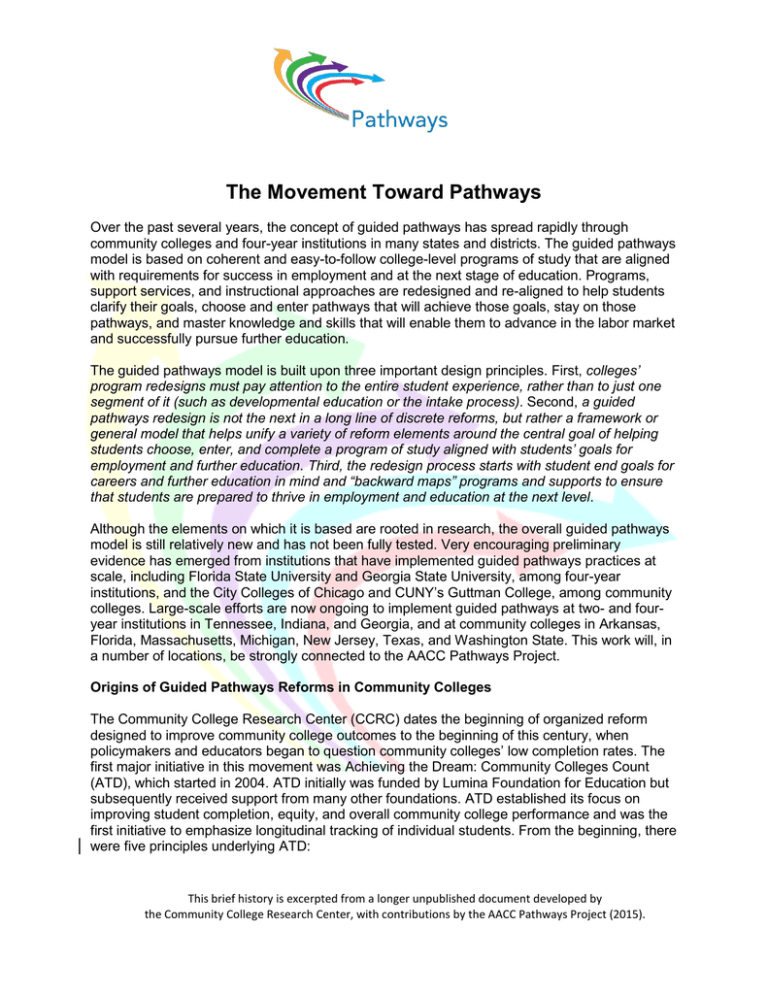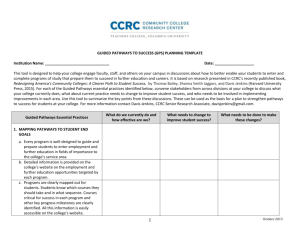The Movement Toward Pathways
advertisement

The Movement Toward Pathways Over the past several years, the concept of guided pathways has spread rapidly through community colleges and four-year institutions in many states and districts. The guided pathways model is based on coherent and easy-to-follow college-level programs of study that are aligned with requirements for success in employment and at the next stage of education. Programs, support services, and instructional approaches are redesigned and re-aligned to help students clarify their goals, choose and enter pathways that will achieve those goals, stay on those pathways, and master knowledge and skills that will enable them to advance in the labor market and successfully pursue further education. The guided pathways model is built upon three important design principles. First, colleges’ program redesigns must pay attention to the entire student experience, rather than to just one segment of it (such as developmental education or the intake process). Second, a guided pathways redesign is not the next in a long line of discrete reforms, but rather a framework or general model that helps unify a variety of reform elements around the central goal of helping students choose, enter, and complete a program of study aligned with students’ goals for employment and further education. Third, the redesign process starts with student end goals for careers and further education in mind and “backward maps” programs and supports to ensure that students are prepared to thrive in employment and education at the next level. Although the elements on which it is based are rooted in research, the overall guided pathways model is still relatively new and has not been fully tested. Very encouraging preliminary evidence has emerged from institutions that have implemented guided pathways practices at scale, including Florida State University and Georgia State University, among four-year institutions, and the City Colleges of Chicago and CUNY’s Guttman College, among community colleges. Large-scale efforts are now ongoing to implement guided pathways at two- and fouryear institutions in Tennessee, Indiana, and Georgia, and at community colleges in Arkansas, Florida, Massachusetts, Michigan, New Jersey, Texas, and Washington State. This work will, in a number of locations, be strongly connected to the AACC Pathways Project. Origins of Guided Pathways Reforms in Community Colleges The Community College Research Center (CCRC) dates the beginning of organized reform designed to improve community college outcomes to the beginning of this century, when policymakers and educators began to question community colleges’ low completion rates. The first major initiative in this movement was Achieving the Dream: Community Colleges Count (ATD), which started in 2004. ATD initially was funded by Lumina Foundation for Education but subsequently received support from many other foundations. ATD established its focus on improving student completion, equity, and overall community college performance and was the first initiative to emphasize longitudinal tracking of individual students. From the beginning, there were five principles underlying ATD: This brief history is excerpted from a longer unpublished document developed by the Community College Research Center, with contributions by the AACC Pathways Project (2015). (1) Secure leadership commitment. (2) Use data to prioritize actions. (3) Engage stakeholders. (4) Implement, evaluate, and improve intervention strategies. (5) Establish a culture of continuous improvement. [Note: these principles recently have been updated and are reflected in ATD’s 2016 Institutional Capacity Framework.] In 2010, ATD became an independent non-profit organization, but the field learned several important lessons from the first six years of the initiative, when ATD had functioned as a grantfunded activity. First, despite the emphasis on comprehensive organizational change, most of the reforms initiated by ATD colleges were relatively focused efforts involving relatively few students, and they were usually directed at only a single segment of the student experience, primarily the intake system and developmental education in particular. Second, while some of these focused reforms improved outcomes for the participating students, the efforts in general were not large enough or sustained enough to influence the overall performance of the institutions. Thus, while focused programs were sometimes successful, they did not typically lead to improved outcomes for large numbers of students (Rutschow et al., 2011). The Bill & Melinda Gates Foundation became involved with ATD in 2009 through the Developmental Education Initiative (DEI), in which 15 ATD colleges participated. DEI was explicitly designed to identify specific developmental education pilot reforms at ATD colleges that were improving student outcomes, and to scale those reforms throughout the developmental education population. In general, colleges were unable to achieve wide-scale implementation of their chosen programs within the three-year timeframe, suggesting that the pilot-to-scale strategy is not an effective approach to reform (Quint et al., 2013*). The DEI programs also tended to be implemented in isolation from college-level programs and the broader set of support services within colleges. During the latter half of the 2000s, a growing volume of research by CCRC and others established additional knowledge and insights that formed the foundation for further advances in policy and practice. These advances occurred in three broad areas. First, the field began to draw insights from behavioral economics to argue that the community college environment was too complex and confusing for students, suggesting that college-level programs needed to be simplified and made more coherent. The implications of behavioral economics research for community college practice was formally articulated in a BMGF-funded CCRC paper, The Shapeless River (Scott-Clayton, 2011*). Second, CCRC and others produced research showing that students who gained early momentum (by passing the gateway courses in a program of study in their first year of college) were much more likely to graduate than those who took more time to enter a program (Attewell, Heil, & Reisel, 2011; Jenkins & Cho, 2012*). Third, research by CCRC and others on developmental education concluded that developmental assessments did not accurately identify students’ needs, and traditional developmental coursework did not help underprepared students succeed at higher rates, while accelerated and contextualized coursework held more promise (e. g., Bailey, 2009; Edgecombe, 2011*; Jenkins et al., 2010; Perin, 2011*; Scott-Clayton, 2012*; Zeidenberg, Cho, & Jenkins, 2010*). These findings provided the impetus for the development and wide-scale adoption of “co-requisite” models, which place many more students into college-level courses while providing them with the support they need to succeed in those courses. The broader implications of the ATD and DEI experience and related research was that developmental education should not be conceptualized as a separate activity, but rather should be designed This brief history is excerpted from a longer unpublished document developed by the Community College Research Center, with contributions by the AACC Pathways Project (2015). 2 into a broader model as part of an on-ramp to college level programs of study. This became a fundamental element of more comprehensive models. The ATD and DEI experiences, together with the insights beginning to emerge from the research discussed above, contributed to the conceptual foundation of the Bill & Melinda Gatesfunded Completion by Design (CBD) initiative, which began in 2011. CBD was based on the following principles: (1) Accelerate entry into coherent programs of study. (2) Minimize the time required to get college-ready. (3) Ensure that students know the requirements to succeed. (4) Customize and contextualize instruction. (5) Integrate student supports with instruction. (6) Continually monitor student progress and proactively provide feedback. (7) Reward behaviors that contribute to completion. (8) Leverage technology to improve learning and program delivery. Most of the components of the guided pathways model as understood today were incorporated into these eight principles. At the time, these elements represented a new and ambitious agenda, unfamiliar to participating colleges and even to some extent to the program organizers and technical assistance providers. As a result, participating colleges were allowed to exercise a great deal of flexibility in the implementation of these principles. In practice, each college chose to implement the subset of principles that most appealed to that institution, resulting in wide variation in the implementation of the CBD “model.” While not ideal in terms of evaluating a well-defined model, CBD’s variety in implementation did provide CCRC with the opportunity to observe the implications of different combinations of these elements. Their resulting report to BMGF (Jenkins & Ran, 2015*) suggested that the most successful colleges used the college-level program of study as a central organizing point for college reforms. At the same time, the experience with CBD and associated insights led to the solidification and elaboration of the guided pathways model that is articulated in CCRC’s book, Redesigning America’s Community Colleges (Bailey, Jaggars, & Jenkins, 2015*). In addition, CBD created the conditions that allowed participating colleges such as Miami Dade College, Davidson County Community College (NC), Lorain County Community College (OH), and Sinclair Community College (OH) to become leaders or emerging leaders in the guided pathways movement. The initiative also trained a cadre of administrators and change management experts who are now engaged in the Bill & Melinda Gates Foundation’s recent pathways-focused investment—the Pathways Project organized by AACC. Other institutions emerging as leaders in the guided pathways movement, such as the 2- and 4-year institutions under the Tennessee Board of Regents and the City Colleges of Chicago, were directly inspired and influenced by the CBD experience. The guided pathways model is based on research suggesting that community colleges and broad-access four-year institutions are currently operating under a “cafeteria” model that was appropriate to their primary mission in the 1960s, 70s, 80s, and 90s, which was to dramatically expand access to higher education—a mission they fulfilled beyond expectation. However, cafeteria colleges are not well designed to address the need of today’s students, who want to enter and complete programs that confer economically valuable certificates and degrees as quickly and efficiently as possible. At cafeteria colleges, the best pathways that students can take into and through programs of study and to their career or further-education end goals are This brief history is excerpted from a longer unpublished document developed by the Community College Research Center, with contributions by the AACC Pathways Project (2015). 3 not clear. There are too many choices, programs lack educational coherence, and students’ progress is not monitored. Research on organizational effectiveness from within and outside education strongly indicates that to substantially improve student completion and learning, discrete innovations—even when they are implemented at scale—are not sufficient; rather, colleges need to redesign programs and support services comprehensively and at scale to support student progression and learning. A small but growing number of community colleges and four-year institutions across the country are beginning to see substantial gains in student outcomes by redesigning programs and services to improve the student experience along four dimensions: (1) create clear curricular pathways to employment and further education, (2) help students get on a path, (3) keep students on a path, and (4) ensure that students are learning along their path. In summary, this series of important initiatives and accompanying research has yielded crucial insights that have helped form the foundation of the pathways movement. Now comes the next generation of guided pathways reforms, which will help to deepen knowledge about the efficacy of the model, build the capacity of the community college field for designing and implementing large-scale change, and identify effective strategies for maximizing colleges’ impacts on student learning and success. This brief history is excerpted from a longer unpublished document developed by the Community College Research Center, with contributions by the AACC Pathways Project (2015). 4 Works Cited Attewell, P., Heil, S., & Reisel, L. (2012). What is academic momentum? And does it matter? Educational Evaluation and Policy Analysis, 34(1), 27–44. Bailey, T. R., Jaggars, S. S., & Jenkins, D. (2015). * Redesigning America’s community colleges: A clearer path to student success. Cambridge, MA: Harvard University Press. Bailey, T. (2009). Challenge and opportunity: Rethinking the role and function of developmental education in community college. New Directions for Community Colleges, 145, 11–30. Bailey, T., Jeong, D. W., & Cho, S. W. (2010). Referral, enrollment, and completion in developmental education sequences in community colleges. Economics of Education Review, 29(2), 255–270. Edgecombe, N. (2011). * Accelerating the academic achievement of students referred to developmental education (CCRC Working Paper No. 30). New York, NY: Columbia University, Teachers College, Community College Research Center. Jenkins, D., & Cho, S. W. (2012). * Get with the program: Accelerating community college students’ entry into and completion of programs of study (CCRC Working Paper No. 32). New York, NY: Columbia University, Teachers College, Community College Research Center. Jenkins, D., & Ran, F. (2015). * A first look at the first CBD implementation year (2013-14): Changes in near-term KPIs and potential to affect longer term student outcomes. Unpublished report to the Bill & Melinda Gates Foundation. Jenkins, D., Speroni, C., Belfield, C., Jaggars, S. S., & Edgecombe, N. (2010). A model for accelerating academic success of community college remedial English students: Is the Accelerated Learning Program (ALP) effective and affordable (CCRC Working Paper No. 21). New York, NY: Columbia University, Teachers College, Community College Research Center. Perin, D. (2011). * Facilitating student learning through contextualization (CCRC Working Paper No. 29). New York, NY: Columbia University, Teachers College, Community College Research Center. Quint, J., Jaggars, S. S., Byndloss, C., & Magazinnik, A. (2013). * Bringing developmental education to scale: Lessons from the Developmental Education Initiative. New York, NY: MDRC. Rutschow, E. Z., Richburg-Hayes, L., Brock, T., Orr, G., Cerna, O., Kerrigan, M. R., Jenkins, D., Gooden, S., & Martin, K. (2011). Turning the tide: Five years of Achieving the Dream in community colleges. New York, NY: MDRC. Scott-Clayton, J. (2011). * The shapeless river: Does a lack of structure inhibit students’ progress at community colleges? (CCRC Working Paper No. 25). New York, NY: Columbia University, Teachers College, Community College Research Center. Scott-Clayton, J. (2012). * Do high-stakes placement exams predict college success? (CCRC Working Paper No. 41). New York, NY: Columbia University, Teachers College, Community College Research Center. Zeidenberg, M., Cho, S-W. , & Jenkins, D. (2010). * Washington State’s Integrated Basic Education and Skills Training Program (I-BEST): New evidence of effectiveness. (CCRC Working Paper No. 20). New York, NY: Columbia University, Teachers College, Community College Research Center. This brief history is excerpted from a longer unpublished document developed by the Community College Research Center, with contributions by the AACC Pathways Project (2015). 5






